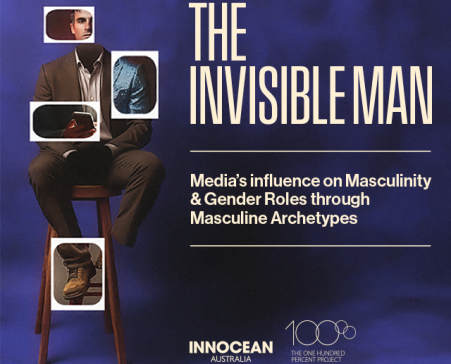Diversity of Thought Blog
Gender Equality in Australian School Leadership – Mark Morris, Director, The 100% Project

Schools have an incredible potential to drive societal gender equality, as workplaces, but also in their role shaping values in children, and positively challenging gender stereotypes and roles in families. Equity, fairness and doing the right thing for the current workforce should be enough to catalyse action, but it’s also about setting a positive example for the next generation of future leaders. When leadership doesn’t embody equality, this represents a lost opportunity to help the nation toward social change.
In Australia, despite women dominating the teaching profession, their representation in leadership roles — especially in principal and school governance positions — remains low. This article reviews data and evidence on gender distribution across workforce and leadership roles within Australian schools, such as teachers, principals, board directors, and board chairs. It uses data from key sources and research to highlight that leadership in Australian schools is far from gender equal.
Teachers
To truly consider the balance in school leadership roles, the overall school workforce must be considered and whether the leadership casemix is, or isn’t, a representation of that workforce. According to the Australian Curriculum, Assessment and Reporting Authority (ACARA, 2022), approximately 72% of teachers in Australian schools are women. More pronounced in primary schooling at 82.4%, but still also obvious in secondary schools with 61.5% female teaching staff. These figures have remained stable over the past few years, underscoring the gendered trend of the teaching profession. Women also dominate early childhood education and other care-related roles. However, there is a stark underrepresentation of women in school leadership, particularly in more senior roles.
School Leadership: Principals and Assistant Principals
The Australian Bureau of Statistics (ABS, 2023) reports that while women make up 72% of the teaching workforce, only 34% of principals in Australian schools are female. This figure is more pronounced in private schools, where women account for only 28% of principals (ABS, 2023). In contrast, public schools have seen slightly better gender representation in leadership, with around 40% of public school principals being women (WGEA, 2024). This is below the international average across all OECD countries of 45% (Global Education Monitoring Report, 2023); another example in which Australia is performing below average internationally in education. This disparity is not unique to Australian schools; it mirrors trends observed in other industries, where women often encounter barriers when advancing to leadership positions. While the gender pay gap in education is lower than the national average, hovering around 6% (WGEA, 2024), this does not entirely explain the lack of women in top leadership roles. Further, in a sector heavily dominated by women, it could be fairly expected to have no gap at all in either pay or leadership.
School Boards: Directors and Chairs
An even deeper gender divide is seen in governance roles at the board level. 75% of board chairs in Australian schools are men, with women holding only 25% of these influential positions (WGEA, 2024). This gender gap extends to school board directors, with 62% of board directors being male (WGEA, 2024). These figures reflect a systemic issue where women, despite their presence in teaching and leadership roles, are biased against in higher decision-making and governance levels. This trend seems particularly prominent in private schools, where male representation on school boards remains dominant. How does this compare to boards in general? The percentage of women on Australian boards is currently 34.2% (AICD, 2023), with 19.4% female board chairs. So, compared to average figures, education as a sector is slightly ahead, but when considering the vast majority of women comprising the schools’ workforce, there is no excuse for under-representation in leadership roles.
The distribution of gender in school leadership is more balanced in public schools, which are government-funded, compared to private schools. According to a Barcley Consulting study on gender equity in Gold Coast schools (2023), public schools tend to offer more gender-inclusive policies which could in part explain some of the variance seen in the gender equity in their leadership profiles. Other aspects of gender inequity highlighted in this study included some schools enforcing rigid gender ideologies through appearance policies (e.g. hair, uniforms, attire) onto both students and staff.
The Gender Pay Gap
Despite the higher proportion of women in teaching roles, the gender pay gap in education, although smaller than in many other sectors, is still significant. In 2023-24 women in the education sector earned approximately 6% less than their male counterparts, a figure lower than the national average of 13.4% (WGEA, 2024). However, the lack of women in principal positions — where pay is highest — means that, while the gap is narrower at lower levels of teaching, it becomes more pronounced at the leadership level. The story this picture of gender imbalance conveys to students and children is critical. At the moment, the story reflected by the data could be described as “women are more commonly toward the bottom of the school hierarchy and visibly do more of the work, where men are more likely at the top, in charge and earning more”; leaning in to the broader question, ‘how patriarchal are schools in general?’.
Policy and Progress
The Australian Government has acknowledged these barriers through various initiatives aimed at increasing gender diversity in leadership roles. For example, programs designed to improve leadership skills for women and provide better support for those balancing caregiving and leadership responsibilities have gained traction in some public school systems. There is a growing recognition of the need to make leadership training more inclusive, with a focus on mentorship programs for women and increased representation of women on school boards. But these types of initiatives also are at risk of aligning with the thinking that ‘women are the problem, so let’s fix women’. To have a significant impact at a systemic level requires a multifaceted long-term strategy that recognises the current trends and asks; why? If men are largely holding the most senior leadership roles in the schools sector then these men need to take responsibility for the succession of women into leadership roles. And, as with other strategic initiatives, if the nation wants to see men’s behaviour change, there may be a need for a targeted initiative to enable that change.
The National Strategy to Achieve Gender Equality, launched in 2024 and titled ‘Working for Women: A Strategy for Gender Equality’ includes a key priority are for ‘leadership, representation and decision-making’ highlighting the importance of this at a national level “to ensure women are leading and building the economy in equal measure to men”. Additionally, with an AITSL report, National Trends: Teacher Workforce (2023), indicating that more teachers are working longer hours, complaining of burnout, and planning to quit the profession prior to retirement, perhaps the long-term workforce planning for Australia’s future teacher demands needs to be built upon a pillar of gender equality, or if not, will the nation be able to cater to an increasing population?
Parental involvement
An Australian Institute of Family Studies (AIFS) report (2024) describes that 56% of opposite sex parent couples reported that most or all parenting (including the unpaid work around schooling) is done by the mother compared to 5% reporting most or all parenting being done by the father. When the mental load is considered the gender divide widens further, with 78% of opposite sex parent couples reporting that the mother carries most of or all of the mental parenting load, compared to 3% reporting most or all being carried by the father. Whether the parents work full-time or not is also a gendered aspect, with 42% of mothers (in opposite sex parent couples) doing most or all of the parenting even when both parents work full-time. Comparatively only 5% of fathers reported doing most or all of the parenting in these circumstances.
When we think of these disparities in a school context, the parenting tasks are endless. The drop-offs, the pickups, the tuckshop, the uniforms, the lunches, the parent committees, the volunteering, and then there’s… THE EMAILS! So, if children are seeing the gender divide in school staff, and then further in the parenting tasks around schooling, all of this combines to display a perfect storm of gender inequality on a daily basis. The 100% Project’s ‘Breaking Dad’ research in 2021 demonstrated the potential that creating a psychologically safe environment at work could have on increasing men’s likelihood to request family friendly work arrangements and spend more time in active parenting. Could it be hypothesised then that workplaces and employers play a critical role in enabling gender equality in the home, and in schools?
Why?
A 2024 report from The 100% Project (2024), ‘Saving the Fall: Can Psychological Safety Help Women Navigate the Glass Cliff?’, on psychological safety and the gendered nature of leadership, suggests that psychological safety — the ability to be vulnerable without fear of judgement — is a crucial factor for women in navigating leadership roles, especially in environments that are heavily male-dominated.
But according to a ‘Sexual Harassment of Teachers (SHoT)’ report (2024), 47.9% of female teachers have been sexually harassed in a school environment. 80.6% of teachers who personally experienced sexual harassment at school were harassed by a student. Raising the questions, are schools doing enough to mitigate against psychosocial hazards? Are schools doing enough to fulfil their legal Positive Duty obligations? And are schools doing enough to address the upstream drivers of sexual harassment and violence as opposed to simply reactively dealing with the results afterward?
A report by The Australian Catholic University (2024) highlights that female educators face systemic discrimination, gender bias and hostility that actively hampers their progression into school leadership roles. “Women are often perceived as less competent than their male counterparts, with perceptions of being too emotional, unpredictable, weak and difficult to work with” it details. “The pathway for women to become principals is often filled with hostility and lack of support, including difficulty balancing home and work responsibilities, discrimination, gender bias, stereotypes, racism, and religious or cultural constraints that reinforce patriarchal structures.” One example is the concept of the “good old boy network”, where men back each other to progress, often at the expense of women, the report found.
Conclusion
Despite the modest progress made in recent years, gender equality in school leadership in Australia has a long way to go. Women continue to be underrepresented in principal and board roles, and moreso in private schools. Although some initiatives are underway to address these issues, barriers such as societal expectations, cultural biases, and structural inequalities persist. However, there is hope that through continued policy reform and specific programs that address gender inequality, the gender gap in educational leadership will continue to narrow.
For meaningful change, the conversation must shift to creating psychologically and physically safe spaces for staff and students, embracing equity and inclusion at every level from policy to practice. Public schools are currently leading the way, with gender equality quickly becoming a critical element within the Student Value Proposition for any school. So private schools could follow the public sector lead in order to contribute to the national objective. To improve gender equality in leadership in schools at a system level will require both top-down and bottom-up approaches. Setting targets to ensure that leadership is reflective of the workforce it represents is part of the solution.
As Australia works toward broader societal change in gender equality, schools must lead by example, fostering inclusive, equitable, diverse, and supportive environments that empower all educators to rise to leadership positions, regardless of gender. Schools have an incredible opportunity to drive societal gender equality, as workplaces, but also in their role shaping values in children, and positively influencing gender stereotypes and roles in families.
Follow The 100% Project on LinkedIn if you’re interested to learn more about our research or reach out to us if you want to get involved or explore partnership opportunities with us.
References
• Australian Bureau of Statistics (ABS). (2022-2023). Labour force, Australia. View here
• Australian Curriculum, Assessment and Reporting Authority (ACARA). (2022). Annual report 2024. Download here
• Australian Catholic University (ACU). (2024). Empowering Women for Principalship. View here
• Australian Government. (2024). Working for Women: A Strategy for Gender Equality. View here
• Australian Institute of Company Directors (AICD). (2023). Women on Boards. View here
• Australian Institute of Family Studies (AIFS). (2024). How mothers and fathers share child care in Australia. Download here
• Australian Institute for Teaching and School Leadership (AITSL). (2023). Diversity in School Leadership. Download here
• Australian Institute for Teaching and School Leadership (AITSL). (2023). National Trends: Teacher Workforce. View here
• Barcley Consulting. (2023). Gender equity in Gold Coast schools. View here
• Collective Shout. (2024). Sexual Harassment of Teachers. Download here
• Governance Institute of Australia. (2024). 2024 Board Diversity Index. Download here
• INNOCEAN and The 100% Project. (2024). Invisible Man. View here
• The 100% Project. (2021). Breaking Dad: Why Men Hold the Power in Education Leadership. Download here
• The 100% Project. (2024). Saving the Fall: Can Psychological Safety Help Women Navigate the Glass Cliff? Download here
• UNESCO. (2023). Global Education and Monitoring Report 2023. Download here
• Workplace Gender Equality Agency (WGEA). (2024). Gender equality scorecard 2023-24. View here

